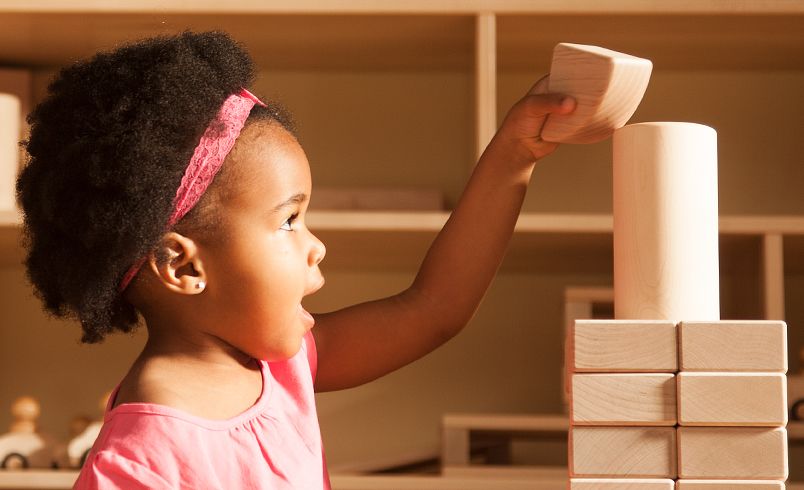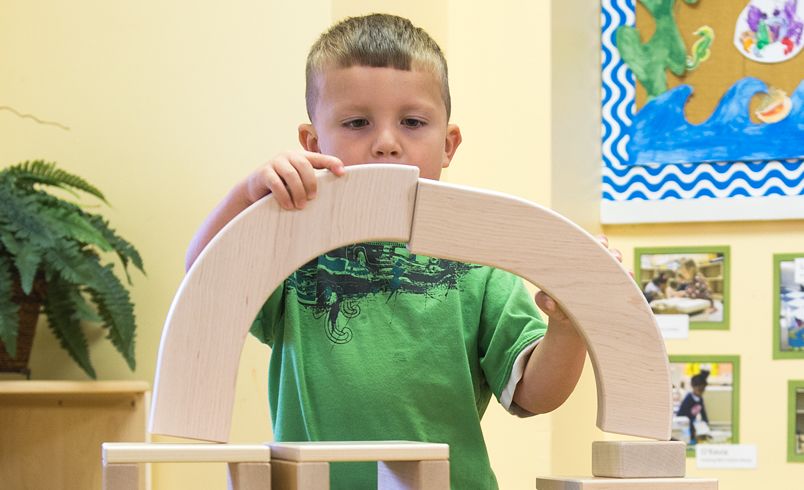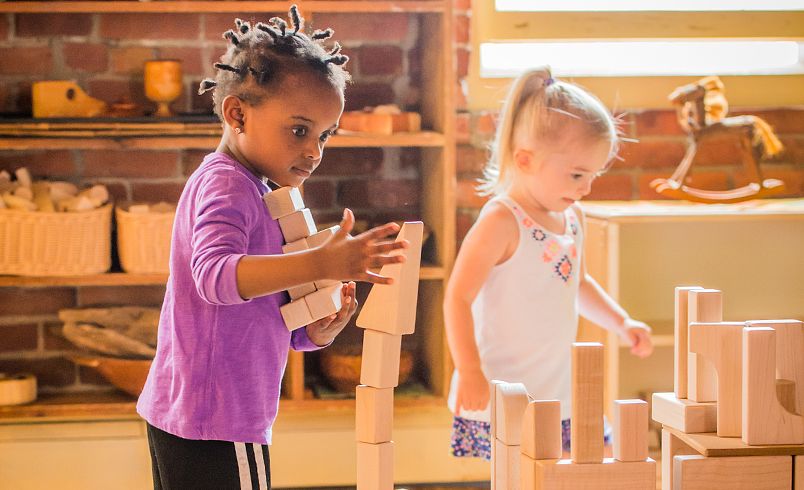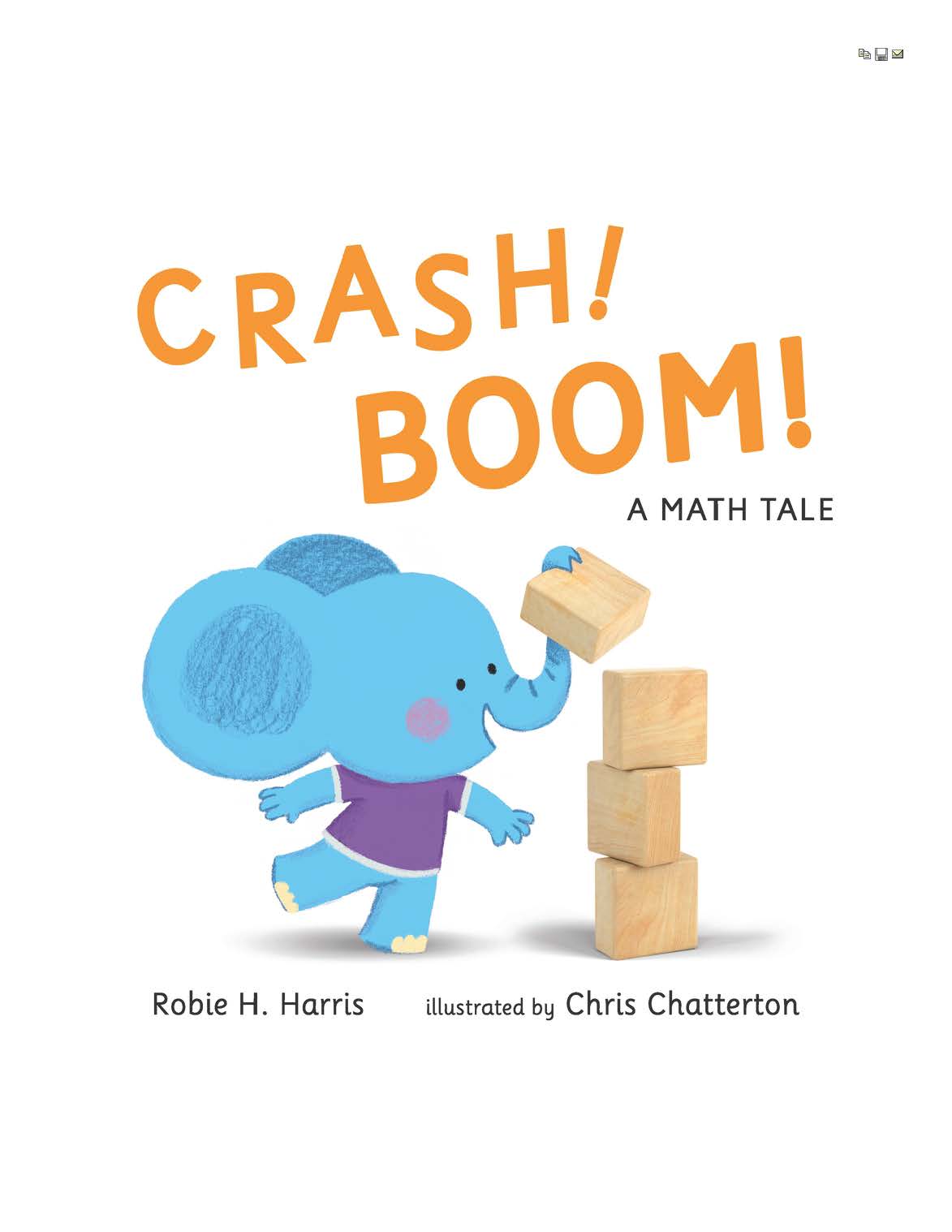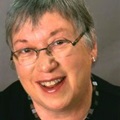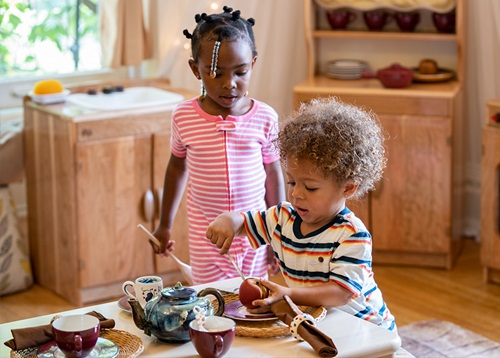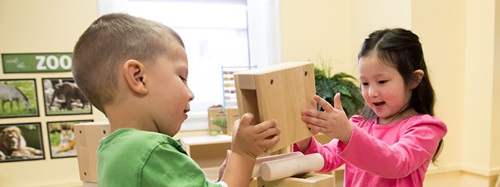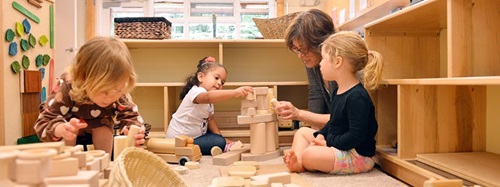Building Blocks of Math Skills
The Many Ways Block Building Supports Young Children’s Discovery of Early Math Concepts
| May 2018Unit blocks have been a mainstay in preschool classrooms for over 100 years. However, their great potential and versatility as a learning tool is too often underestimated. Coming at this topic from three unique angles, a classroom teacher, a college-level mathematics professor, and a children’s book author argue the importance of unit blocks in establishing a solid foundation for mathematical understanding.
A Teacher of Young Children: Emily Linsay, M.S.Ed
On Sonja’s first day in the block area, she stacked one block on another until the stack reached her head. She made two similar towers. Then with her hand she drew an invisible line in the air to compare the tops of the structures to each other and to her own forehead. Working in our pre-k classroom’s block area allowed Sonja to explore the mathematical concepts of balance, height, and measurement.
The teacher in the block area noted what Sonya and the other builders were working on and discovering: from measurement to balance, size and shape, number and pattern, and spatial organization and arrangement. These observations informed us about each child’s development, while also steering us to mathematical topics to bring to the group.
At morning meeting, we focused on shapes and attributes. We examined two blocks, a curve and a half unit and asked, “How are these blocks the same and different?” Another day, we brought blocks to the meeting and said, “There are the same number of blocks in this bin as there are children in our classroom. How many blocks are in the bin? Why do you think that?” and “How can we check our thinking?” After each meeting highlighting blocks, children’s block work evolved in new ways.
Later in the year, our study of boats challenged children’s spatial thinking in the block area and led to different building problems. After visiting a nearby river, the children created a construction paper river covered by clear contact paper on the block area floor. Through trial and error, Donovan engaged in the engineering task of spanning the new river with a bridge high enough for model boats to fit under. Once the bridge was high enough and sturdy, he and Clara partnered to create inclines of ramp blocks on both sides of the bridge.
Well-arranged, neatly labeled, and fully stocked block shelves are all the inspiration some children need for building. A teacher’s presence draws in others. More motivation comes from posting photographs of children’s structures, images of well-known buildings, and words and images in books about building, such as Byron Barton’s Building A House and Robie H. Harris’ Crash! Boom! Gather the class around the block area to listen to builders share thoughts about their structures. The mathematical thinking involved in block building continues as children “unbuild” and shelve. These tasks involve matching, counting, and estimating. By working in the block area children experience the math that blocks offer, leading to more complex math understandings in future years.
A Teacher of Teachers: Hal Melnick, Ph.D. Bank Street College of Education
So many teachers I know think about mathematics in narrow terms—a bunch of rules, formulas, and equations to solve and find answers to a mathematical problem. However, this definition is not correct. Mathematics has always been defined as the study of the relationships between objects or quantities.
Wooden unit blocks which can be held, measured, compared, and counted, are a perfect hands-on medium for children to deeply experience these relationships between objects. Caroline Pratt, an innovative and revered early childhood educator, designed these modular blocks in the 1930s. She understood that the blocks would engage children’s creativity, captivate their curiosity, challenge them to be problem-solvers, and offer children a tool to collaborate. Young students are learning math naturally every time they “do” something with objects, such as the Pratt blocks.
For example, building a simple tower provides many learning challenges for a young child. Children experience math concepts as they compare lengths of blocks, find equivalence and stack matched lengths. In addition, children need to master basic neuro-developmental skills to successfully build a steady tower. These include eye-hand motor coordination and spatial ordering, as well as sequencing actions such as: following directions, managing time, maintaining focus, self-monitoring of one’s behavior, controlling mental energy, and holding a clear memory of shapes. Equally important, these skills, called “executive functions,” are life skills that both children and adults need to get any task done.
When young children remove neatly stacked and shelved blocks and begin to build, the blocks often fill up the whole block area. Even though the same amount of blocks are on the floor as on the block shelf, children are often surprised because it looks like there are more blocks on the floor. Eventually, they figure out that there are still the same number of blocks whether on the shelf or in a different configuration on the floor.
Children problem-solve when they design roads, buildings, airports, barns, houses, bridges, or design the many kinds of other structures they may decide to build. They naturally work with volume, area, mass, and the physics of equivalence, non-equivalence, balance points, levers, the concept of a fulcrum, and the impact of gravity. Clearly, unit blocks are an ideal tool to learn math and other important STEM concepts.
A Children’s Book Author: Robie H. Harris
Contrary to a common misunderstanding, early math is about much more than counting. It is also about many other, and seemingly more complex math and other STEM concepts including: height, width, length, balance, gravity, stability, measurement, doubling, estimation, proportion, shape, symmetry, patterns, equivalencies, and prediction. The experience of building with blocks gives young children the chance to think, question, and try to figure out how to solve a problem. Along the way, they often discover a myriad of other math and STEM concepts.
Block building also gives young children the opportunity to try out a new idea such as: “How can I build a tower as tall as me?” or “How can I make my block tower stand up and not fall down?” or “How will I know if it’s as tall as me?” Often failure ensues and with failure comes the chance to figure out why the tower fell down and then try a different idea. When a young child discovers how to make a tower stand up and be as tall as “me” they are engaged in mathematical thinking and problem solving, skills that they will carry with them throughout their lives.
As a children’s book author, I observed young children block building in a preschool setting. At first many children looked puzzled or deep in thought. Gradually they would place one block on top of another, sometimes upright, sometimes flat. Many would stop, look at what they had just constructed, take away or add more blocks, or change the position of a block. As they built, most stopped to look at what they had done in order to figure out what they would change or do next. What I observed was that block building clearly nurtures children’s ability to observe, assess, calculate, plan, and take action.
Soon after, I sat down on my office floor and built and rebuilt with wooden blocks the structure that became the basis of a picture book story, Crash! Boom! A Math Tale, which I was writing at that time. While building with the blocks, I encountered all kinds of math and other STEM concepts such as doubling, measurement, and balance. I wove many of these concepts into my story. Subsequently, illustrator Chris Chatterton wove them into the art for our book. These are the very same concepts children discover when building with blocks. Just like the children, I too had a hands-on experience with block building. That experience enabled me to write a story that I hope will encourage young children to try to build something with blocks they have never built before. The children and I also learned that building with wooden blocks, while often challenging, can still be fun.

